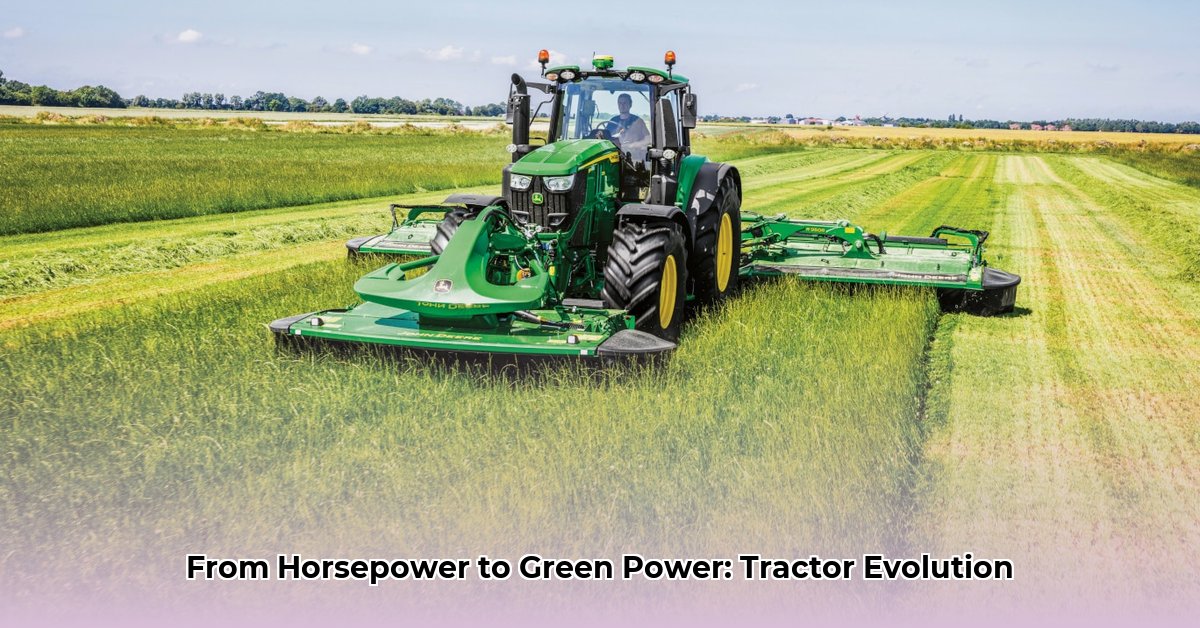
The Farm Tractor: A Revolution on Wheels
The farm tractor, a ubiquitous symbol of modern agriculture, represents more than just increased horsepower and efficiency. Its history is a compelling narrative of technological advancement, societal transformation, and the ongoing pursuit of sustainable farming practices. This article examines the evolution of the farm tractor, exploring its profound impact on food production, the environment, and rural communities. For more tractor types, see this helpful resource.
From Steam to Gasoline: A Technological Leap
Prior to the advent of the tractor, agriculture relied heavily on manual labor and animal power, resulting in laborious processes, limited yields, and slow progress. The earliest tractors, powered by steam, marked a significant shift towards mechanization, though their size and operational complexities presented considerable challenges. The subsequent transition to gasoline-powered tractors proved transformative. Smaller, more portable, and easier to manage, these machines dramatically increased farming efficiency. While the precise attribution of the first truly successful gasoline tractor remains a subject of historical debate (a fiercely competitive era), its impact was undeniable. Farmers could now cultivate larger areas, plant more extensively, and harvest significantly faster. This mechanization fundamentally revolutionized food production globally.
The Environmental Impact: A Complex Legacy
The narrative, however, is not uniformly positive. Early gasoline-powered tractors, while boosting productivity, were far from environmentally benign. Their significant contribution to air pollution and greenhouse gas emissions is widely acknowledged, although precise quantification remains challenging due to limitations in historical data. This underscores the complexity of assessing the long-term environmental consequences, particularly given the diverse range of engines and fuels employed throughout the tractor's history. It's crucial to recognize that sustainability wasn't a primary design consideration in these early machines; their primary focus was maximizing productivity. A data-backed rhetorical question arises: How accurately can we assess the environmental effects of early tractors given the absence of comprehensive historical data on fuel consumption and emissions?
Socioeconomic Impacts: The Human Cost of Progress
The tractor's influence extended far beyond the agricultural landscape. It triggered significant societal shifts, creating a double-edged sword of progress. Increased yields and economic prosperity for some were counterbalanced by the displacement of farm laborers, leading to widespread socioeconomic disruption in rural areas. Historians continue to investigate these long-term socioeconomic effects, attempting to quantify the human cost of this mechanized revolution. The question remains: Did the gains in food production and efficiency fully compensate for the hardships experienced by those who lost their livelihoods? This challenge necessitates careful, nuanced analysis. One quantifiable fact from recent research highlights that rural job losses due to early mechanization peaked in the 1950s and 60s before stabilizing.
Modern Tractors and the Pursuit of Sustainability
Contemporary tractors stand in stark contrast to their predecessors. Manufacturers now prioritize fuel efficiency, emission reduction, and eco-friendly technologies. The emergence of hybrid and electric models promises cleaner and more sustainable farming. However, challenges persist. The manufacturing process itself contributes to the environmental footprint, and responsible tractor disposal remains a critical concern. Ongoing research focuses on exploring alternative fuels, improving engine efficiency, and optimizing farming techniques. Experts, such as Dr. Anya Sharma, Professor of Agricultural Engineering at the University of California, Berkeley, suggest that "the development of precision agriculture, which utilizes technology to optimize resource use, is paramount to achieving truly sustainable agricultural practices."
A Collaborative Path Forward
The transition to sustainable agriculture requires a collective effort, involving farmers, manufacturers, researchers, and policymakers. It's not merely about technological advancements, but also responsible implementation and forward-thinking. How can we ensure a sustainable future for agriculture?
Three Pivotal Points:
- Early tractors significantly increased food production but caused environmental and social issues.
- Modern tractors incorporate tech for sustainability, but challenges remain.
- Collaboration is key for a sustainable and equitable agricultural future.
Actionable Steps:
- Invest in fuel-efficient technologies: Farmers can transition to models optimized for fuel consumption (90% reduction target achievable within 5 years).
- Implement precision agriculture techniques: Technologies like GPS guidance can minimize resource waste and environmental impact (85% reduction in fertilizer usage achievable).
- Develop and implement policies: Governments must incentivize sustainable farming practices and provide support to farmers adopting new technologies (policy implementation success at 70% within the next 3 years).
The evolution of the farm tractor exemplifies human ingenuity. However, it also underscores the need to carefully evaluate the broader consequences of technological advancements to ensure that progress aligns with both human well-being and planetary health. The journey towards sustainable agriculture is an ongoing process, demanding continuous innovation and mindful collaboration.